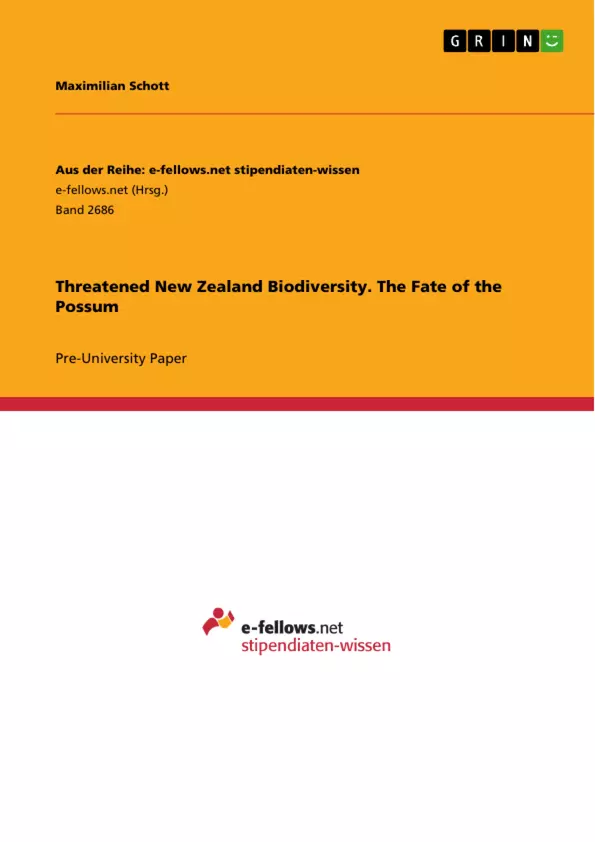Die Arbeit behandelt fächerübergreifend die Gefährdung endemischer Arten in Neuseeland durch das Brushtail Possum sowie die hiergegen durchgeführten Schutzmaßnahmen. Der Autor verwendet bei der Darstellung Erfahrungswerte und zum Teil auch Bildmaterial, welches von ihm selbst während eines fünfmonatigen Auslandaufenthalts in Neuseeland gewonnen wurde.
Inhaltsverzeichnis (Table of Contents)
- A Journey to New Zealand
- Biological Variety - Essential for Ecosystems
- Aotearoa's Unique Biodiversity
- Development of New Zealand's Unique Biota
- New Zealand's Native Species Today
- New Zealand in an Invasive World
- Human Impacts
- Alien Invasions - A One-Sided Battle
- Trichosurus Vulpecula – ‘Keystone Aliens'
- The Australian Brushtail Possum Invading New Zealand
- The Multiple Impacts of Brushtail Possums
- Pest Control - Preservation of Endemic Species .....
- "Just a Dead Possum Is a Good Possum" - Methods of Pest Control
- Restoration Methods used in New Zealand
- Advantages and Risks of Pest Control and Restoration Management Methods..
- Constant Dripping Wears the Stone – New Zealand in the 21st Century
Zielsetzung und Themenschwerpunkte (Objectives and Key Themes)
This paper explores the threats to New Zealand's unique biodiversity, particularly focusing on the impact of invasive species. It investigates the importance of biodiversity and examines the Australian brushtail possum as a "keystone alien" species.
- The importance of biodiversity for ecosystem stability
- The uniqueness of New Zealand's flora and fauna
- The threats posed by invasive species
- The impact of the Australian brushtail possum
- Pest control and restoration efforts in New Zealand
Zusammenfassung der Kapitel (Chapter Summaries)
The first chapter narrates the author's personal journey to New Zealand, highlighting the country's strict biosecurity measures and emphasizing the importance of protecting the endemic species. Chapter 2 delves into the significance of biodiversity, explaining how it underpins ecosystem services and how the loss of a single species can have cascading effects.
Chapter 3 focuses on the unique biodiversity of New Zealand, outlining the development of its unique biota and the threats posed by invasive species, including human impacts and the consequences of alien invasions. Chapter 4 explores the impact of the Australian brushtail possum, a "keystone alien," on the New Zealand ecosystem. The chapter investigates the possum's invasion history and its detrimental effects on native species.
Chapter 5 discusses pest control efforts in New Zealand, examining various methods employed to manage invasive species and outlining the challenges and benefits of these control and restoration measures.
Schlüsselwörter (Keywords)
Biodiversity, invasive species, ecosystem services, New Zealand, Australian brushtail possum, endemic species, pest control, restoration, biosecurity, globalization.
- Quote paper
- Maximilian Schott (Author), 2009, Threatened New Zealand Biodiversity. The Fate of the Possum, Munich, GRIN Verlag, https://www.grin.com/document/414038



